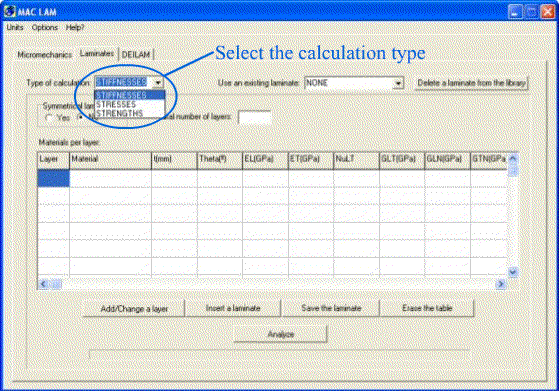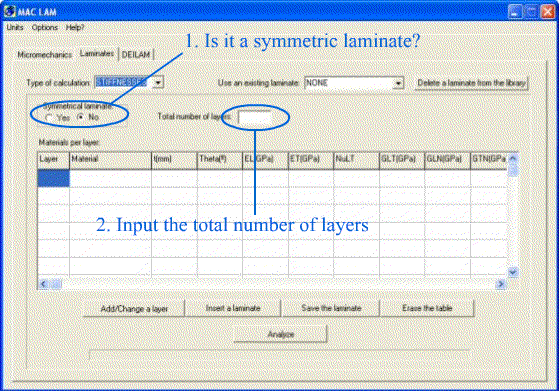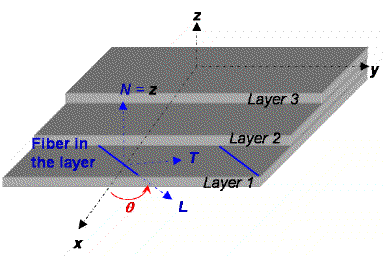2.2
MODULE : LAMINATES
Calculations of this module
are based essentially on the classical model for multi-layeredplates
[1]. For a multi-layered material defined by the user, the module is able
to carry out three kinds of calculations.
- STIFFNESSES
calculation. This type of calculation makes possible to determine global
properties of the multi-layered material, such as the ABBD matrix, apparent
thermal expansion coefficients, apparent Young’s moduli... [1]
- STRESSES
calculations. For a given hygro-thermo-mechanical load the software calculates
the stresses and strains in the layers, and this is done in the global or
local coordinates system (the orthotropy directions in each layer).
- STRENGTHS
calculations. For a given proportional load, the software determines the
load level for which the first ply failure (FPF) occurs. Moreover, the software
makes possible to visualize the intersection of a 2D plane with the failure
envelope (an hypersurface) by making use of the FPF criterion .
It is possible to select
the calculation type in the main window of the module LAMINATES (see Figure
8). All of the calculations may take into account hygrothermal loads (moisture
and temperature). This may be activated by clicking on <<Calculation and
report options>> in the menu bar of the main window in the module.

Figure 8.
Selection of calculation type in LAMINATES module
In order to define a laminate,
the user first has to tell if the laminate is symmetrical or not and enter the
total number of layers (see Figure 9; for a symmetrical
multi-layered material, the total number of layers must be a even number).

Figure 9.
Definition of the multi-layered material symmetry and the total number of layers.
In the module LAMINATES,
the properties which have to be defined for each layer are:
- Name of the material
of which the layer is made
- Thickness of the material
of which the layer is made in mm or min (mili-inches)
- Angle q
(Theta) in degrees (it
is an angle in the orthotropy direction L with respect to the global
x-axis of the laminate, see Figure 10).

Figure 10.
Global (x, y, z) and local (L, T, N)
directions
- Elastic properties in
the orthotropy directions ( L, T, N )
- Young’s moduli
L and ET in GPa or in MPsi.
- Shear moduli GLT,
GLN, GTN in GPa or in MPsi.
It is necessary to enter the last two shear modulii in order to determine
the out-of-plane stiffnesses of the laminate.
- Poisson’s ratio
nLT
.
- Thermal expansion coefficients
aL,
aT
and aLT
in the other orthotropy directions ( L, T, N ). Their
units are (°C)-1 or(°F)-1. These
data are necessary only in case you decide to take into account the thermal
strains.
- Hygroscopic coefficients
bL,
bT
and bLT
. These data are necessary
only in case you decide to take into account the humidity absorption.
- Failure criterion and
criterion data (necessary only for calculating STRENGTHS). Three kinds of
criteria may be considered:
- The Tsai-Hill criterion.
In the column <<Criterion>> you have to type 1. The data you
have to enter for this kind of criterion are:
- Xt
(Xt > 0), the tensile strength in the fibers
direction (L), in MPa or in KPsi
- Yt
(Yt > 0), the tensile strength in the transverse
direction (T), in MPa or in KPsi
- S (S
> 0), the longitudinal-transverse shear strength, in MPa
or in KPsi
- The Hoffman criterion.
In the column <<Criterion>> you have to type 2. The data you
have to enter for this kind of criterion are:
- Xt
(Xt > 0), the tensile strength in the fibers
direction, (L) in MPa or in KPsi
- Xc
(Xc > 0), the compressive strength in the fibers
direction, (L) in MPa or in KPsi
- Yt
(Yt > 0), the tensile strength in the transverse
direction (T), in MPa or in KPsi
- Yc
(Yc > 0), the compressive strength in the transverse
direction (T), in MPa or in Kpsi
- S (S
> 0), the longitudinal-transverse shear strength, in MPa
or in KPsi
- The Tsai-Wu criterion.
In the column <<Criterion>> you have to type 3. The data that
you should enter for this kind of criterion are the same as for the Hoffman
criterion, but you also have to enter the coefficient value F12
which appears in the criterion. The F12 units are (MPa)-2
or (KPsi)-2.
In order to enter the above-said
layers properties, the user may proceed in several ways. It is worth underlining
that this task may be done quickly thanks to the libraries used by MAC LAM
References
[1] R.M. Jones, "Mechanics of composite materials",
second edition, Taylor & Francis, United States, 1999.
